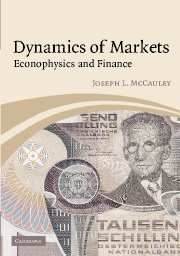Book contents
- Frontmatter
- Contents
- Preface
- 1 The moving target
- 2 Neo-classical economic theory
- 3 Probability and stochastic processes
- 4 Scaling the ivory tower of finance
- 5 Standard betting procedures in portfolio selection theory
- 6 Dynamics of financial markets, volatility, and option pricing
- 7 Thermodynamic analogies vs instability of markets
- 8 Scaling, correlations, and cascades in finance and turbulence
- 9 What is complexity?
- References
- Index
7 - Thermodynamic analogies vs instability of markets
Published online by Cambridge University Press: 31 October 2009
- Frontmatter
- Contents
- Preface
- 1 The moving target
- 2 Neo-classical economic theory
- 3 Probability and stochastic processes
- 4 Scaling the ivory tower of finance
- 5 Standard betting procedures in portfolio selection theory
- 6 Dynamics of financial markets, volatility, and option pricing
- 7 Thermodynamic analogies vs instability of markets
- 8 Scaling, correlations, and cascades in finance and turbulence
- 9 What is complexity?
- References
- Index
Summary
Liquidity and approximately reversible trading
The question of whether a thermodynamic analogy with economics is possible goes back at least to von Neumann.We will attempt to interpret a standard hedging strategy by using thermodynamic ideas (McCauley, 2003a). The example provided by a standard hedging strategy illustrates why thermodynamic analogies fail in trying to describe economic behavior.
We will see that normal trading based on the replicating, self-financing hedging strategy (Baxter and Rennie, 1995) provides us with a partial analogy with thermodynamics, where market liquidity of rapidly and frequently traded assets plays the role of the heat bath and the absence of arbitrage possibilities would have to be analogous to thermal equilibrium in order for the analogy to work. We use statistical physics to explain why the condition for “no-arbitrage” fails as an equilibrium analogy.
In looking for an analogy with thermodynamics we will concentrate on three things, using as observable variables the prices and quantities held of financial assets: an empirically meaningful definition of reversibility, an analog of the heat bath, and the appearance of entropy as the measure of market disorder. We define an approximately reversible trade as one where you can reverse your buy or sell order over a very short time interval (on the order of a few seconds or ticks) with only very small percentage losses, in analogy with approximately reversible processes in laboratory experiments in thermodynamics. All that follows assumes that approximately reversible trading is possible although reversible trading is certainly the exception when orders are of large enough size. The notion of a risk-free hedge implicitly assumes adequate liquidity from the start.
- Type
- Chapter
- Information
- Dynamics of MarketsEconophysics and Finance, pp. 147 - 160Publisher: Cambridge University PressPrint publication year: 2004



